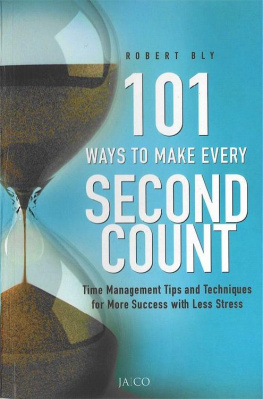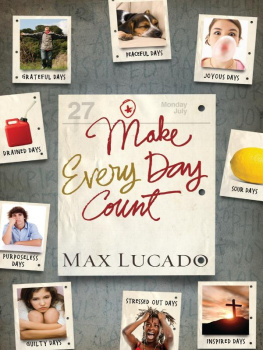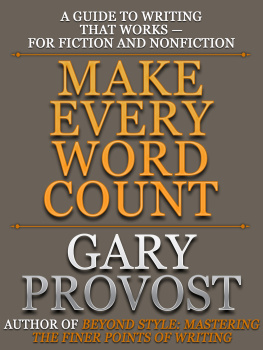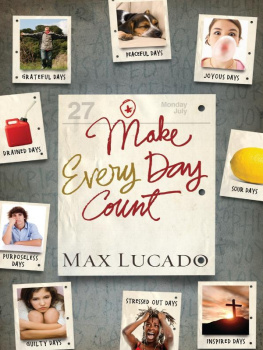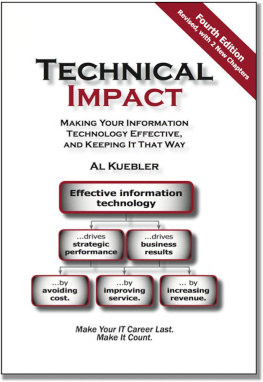Robert W Bly - 101 Ways to Make Every Second Count
Here you can read online Robert W Bly - 101 Ways to Make Every Second Count full text of the book (entire story) in english for free. Download pdf and epub, get meaning, cover and reviews about this ebook. year: 2000, publisher: Jaico Publ. House, genre: Home and family. Description of the work, (preface) as well as reviews are available. Best literature library LitArk.com created for fans of good reading and offers a wide selection of genres:
Romance novel
Science fiction
Adventure
Detective
Science
History
Home and family
Prose
Art
Politics
Computer
Non-fiction
Religion
Business
Children
Humor
Choose a favorite category and find really read worthwhile books. Enjoy immersion in the world of imagination, feel the emotions of the characters or learn something new for yourself, make an fascinating discovery.
- Book:101 Ways to Make Every Second Count
- Author:
- Publisher:Jaico Publ. House
- Genre:
- Year:2000
- Rating:4 / 5
- Favourites:Add to favourites
- Your mark:
- 80
- 1
- 2
- 3
- 4
- 5
101 Ways to Make Every Second Count: summary, description and annotation
We offer to read an annotation, description, summary or preface (depends on what the author of the book "101 Ways to Make Every Second Count" wrote himself). If you haven't found the necessary information about the book — write in the comments, we will try to find it.
101 Ways to Make Every Second Count — read online for free the complete book (whole text) full work
Below is the text of the book, divided by pages. System saving the place of the last page read, allows you to conveniently read the book "101 Ways to Make Every Second Count" online for free, without having to search again every time where you left off. Put a bookmark, and you can go to the page where you finished reading at any time.
Font size:
Interval:
Bookmark:
MAKE EVERY
SECOND COUNT
WAYS To MAKE EVERY
SECOND
COUNT
Time Management Tips and Techniques
for More Success with Less Stress

JAICO PUBLISHING HOUSE
Ahmedabad Bangalore Bhopal Bhubaneswar Chennai
Delhi Hyderabad Kolkata Lucknow Mumbai
Published by Jaico Publishing House
A-2 Jash Chambers, 7-A Sir Phirozshah Mehta Road
Fort, Mumbai - 400 001
www.jaicobooks.com
Robert W. Bly
Published in arrangement with
Career Press, Inc.
Career Press, Inc. 3 Tice Road, Franklin Lakes
NJ07417,U.S.A.
101 WAYS To MAKE EVERY SECOND COUNT
ISBN 81-7224-929-2
First Jaico Impression: 2001
Ninth Jaico Impression: 2010
No part of this book may be reproduced or utilized in
any form or by any means, electronic or
mechanical including photocopying, recording or by any
information storage and retrieval system,
without permission in writing from the publishers.
Printed by
Sanman & Co.
113, Shivshakti Ind. Estate, Marol Naka
Andheri (E), Mumbai - 400 059.
Dedication
To Eleanor Brangan, who taught me how to write
Acknowledgments
Thanks to the staff at Career Press for having in me and in this book... and then helping me to make the manuscript much better than it was when it first crossed their desks.
Contents
Quick Tips to Speed You Up
Do you Really Want to Be Productive?
The 10% Solution for Increased Personal Efficiency
Mastering the Time Management See-Saw
Using Technology to Save Time
Delegation and Outsourcing
Getting Organized
Maximizing Your Personal Energy
Managing Information Overload
Off-loading and Priority Management
Sources and Resources
Introduction
"You may delay, but Time will not."
-Benjamin Franklin, American statesman and philosopher
I'm looking at my watch. It's 8:38 on a Friday morning. By my calculations, I have only approximately 204,400 waking hours of life left. And I intend to make the most of the time still available to me. How about you?
Today, the demands on our time are tremendous. Everyone has too much to do and not enough time to do it. According to an article in Men's Health magazine (March, 1997), 42 percent of American workers believe they are overloaded with work.
We live in the Age of Now. Customers are more demanding than ever. They want everything yesterday. As Miami Herald columnist Leonard Pitts comments, "We move faster than ever, but never quite fast enough." (The Record, October 27, 1997)
"When our society travels at electronic speed, we fall under the sway of a new force...the power of now" says Stephen Bertman, a professor at the University of Windsor, in the article "Stephen Bertman on Hyperculture." (Future Times, Fall, 1998). "It replaces duration with immediacy, permanence with transcience, memory with sensation, insight with impulse." He argues that this acceleration of change contributes to "a growing sense of stress, disorientation, and loss." On the other hand, if you master strategies for coping with today's accelerated pace, you can meet the demands placed upon you while still having time for yourself.
According to an article in American Demographics (January, 1999), consumers have come to view time as their most precious commodity: "To satisfy today's consumer, you need to do business in a real-time worldone in which time and distance collapse, action and response are simultaneous, and customers demand instant gratification."
"We've learned to live by the Rule of 6," notes Gary Springer in an article in the Business-to-Business Marketer (February, 1998). "What used to take six months, now takes six weeks; what used to take six weeks now is wanted in six days; what normally took six days is needed in six hours; and what used to be done in six hours is now expected in six minutes." Technology, says Springer, is responsible for much of this change.
Downsizing has left organizations leaner and meaner. Thousands of workers have been fired, and those who remain must take up the slack and are working harder than ever. According to a Harris poll, the average work week increased from 41 to 50 hours between 1973 and 1993.
A radio commercial for Bigelow Herbal Tea observes, "We seem to live our lives in perpetual motion." In fact, we're so busy, we don't even have time to eat! For instance, the "lunch hour" is disappearing from the American business world. Workers more frequently eat lunch at their desks. The article "Shrinking Lunch Hours" (The Futurist, August/September, 1998) tells us that 40 percent take no lunch break at all and the typical lunch break is 36 minutes, although many people use that time to take care of personal business rather than eat. Recently I read that cereal sales are declining because cereal and milk can't be eaten in the car while driving; breakfast bars meet that need better.
In her book The Worst Years of Our Lives (HarperPerennial), Barbara Ehrenreich writes:
I don't know when the cult of conspicuous busyness began, but it has swept up almost all the upwardly mobile, professional women I know. Already, it is getting hard to recall the days when, for example, "Let's have lunch," meant something other than, "I've got more important things to do than talk to you right now." There was even a time when people used to get together without the excuse of needing to eat somethingwhen, in fact, it was considered rude to talk with your mouth full. In the old days, hardly anybody had an appointment book...
It's not only women, of course; for both sexes, busyness has become an important insignia of upper-middle-class status. Nobody, these days, admits to having a hobby, although two or more careerssay, neurosurgery and an art dealershipis not uncommon, and I am sure we will soon be hearing more about the tribulations of the four-paycheck couple...
You can't jam 25 hours into a 24-hour day. Time is a non-renewable resource that's consumed at a constant and relentless rate. Once an hour is gone, it's gone forever; you can never get it back.
Yet you can solve most of your time-related problemsnot enough time, too much to do, deadlines too short, bosses too demanding, not getting to your own prioritiessimply by in-creasing the productivity of the one resource you can control: you. As management consultant Stephen Covey notes "The only person over whom you have direct and immediate control is yourself."
Some human resource professionals refer to the people in their organizations as "resources." That's cold, but in a way, appropriate and accurate. You are a resource. You have output. To succeed today, you need to increase your output to the next level without making the resource sick, tired, dissatisfied, or unhappy. That's where this book can help.
101 Ways to Make Every Second Count shows you how to succeed in today's competitive, fast-paced world by increasing your own personal productivity, so you can get more done in less time. Going beyond conventional time management, 101 Ways to Make Every Second Count offers diverse strategies and tactics in order to empower you to gain this productivity boost everything from planning, scheduling, organizing, and eliminating time-wasters, to suggestions on improving life habits that give you more energy so you can work better and faster, to using the latest technology to manage information and communicate more efficiently and effectively.
Font size:
Interval:
Bookmark:
Similar books «101 Ways to Make Every Second Count»
Look at similar books to 101 Ways to Make Every Second Count. We have selected literature similar in name and meaning in the hope of providing readers with more options to find new, interesting, not yet read works.
Discussion, reviews of the book 101 Ways to Make Every Second Count and just readers' own opinions. Leave your comments, write what you think about the work, its meaning or the main characters. Specify what exactly you liked and what you didn't like, and why you think so.

